The future of manufacturing is something which has been widely debated in recent months and years. You could go as far as to say that we are on the brink of the biggest change in how we make things since the industrial revolution. There are numerous new tools, processes and materials entering the market.
These in turn bring with them new opportunities for businesses which are able to take advantage of them and give consumers access to more choice in the products they buy, particularly in terms of more personalised items.
In particular, 3D printing, robotics and generative design are set to transform manufacturing in the coming years.
Generative design
At the cutting edge of the manufacturing and design process is generative design. Thanks to advances in design software and computing, software can now design the optimal part based on the parameters of how the part needs to perform.
> See also: Will 3D printing affect the economy?
There are huge opportunities to take advantage of this technology in a whole range of industries, but sectors where weight and form are particularly crucial, such as in automotive and aerospace, offer the most immediate opportunities.
For example, an aerospace company could specify the loads a new bracket has to withstand during aircraft operation, and then the software can optimise the bracket’s design based on this.
This can provide a set of design solutions, which are inherently different to traditional shapes, and these can act as drivers in the overall design process. What the industry has seen over the years is parts being designed to match the manufacturing processes available at the time, and generative design is another example of this.
As the industry starts to get behind generative design, we’ll see the next generation of aircraft parts starting to take shape. More broadly speaking, the opportunities for manufacturing firms to fine-tune each element of any product are huge.
3D Printing
3D printing is part of a series of manufacturing technologies known as additive manufacturing, whereby products are built up by materials being added together in a series of layers, to create the final item.
There are a whole range of industries using additive manufacturing already and it’s been exciting to see the technology take off, both supporting small, start-up businesses and providing new methods for more established players in the market.
In particular, Delcam and Autodesk are working with cutting edge organisations such as Stooki and Cooksongold to develop innovative jewellery for the future.
The latest additive manufacturing technologies, along with laser scanning and the most up to date tooling and casting solutions have provided new ways to design beautiful pieces, in turn providing consumers with interesting new pieces to wear.
The jewellery sector in particular is really making the most of these opportunities. A further example in practice is the PRECIOUS project – a major R&D scheme looking into the use of additive manufacturing in the jewellery industry and developing a commercially viable range of processes for manufacturing based on 3D printing precious metals.
It’s exciting to see how a new technology is playing out in one industry, but we have yet to scratch the surface of the opportunities across the manufacturing spectrum.
Robotics
There has been much talk around the threat to jobs which robots could represent. The reality is that many manufacturing processes already have robotics in place, but they are advancing all the time and allowing us to create incredible things and innovate in hugely significant ways.
> See also: Why manufacturers need to wake up to the Internet of Things
But this doesn’t present a threat to careers, but more of an opportunity to drive innovation. For example, robotics in manufacturing allows us to create new shapes and designs much more efficiently than even a couple of years ago.
From sculpting and machining foam and resin, to laser cutting and finishing, robotics can support our manufacturing processes by delivering more accuracy in intricate designs, on a large scale.
Through working with new design techniques from advances in software, robotics can deliver incredible outputs, supporting the designers and manufacturers in the industry. A fantastic example of this is special effects firm Artem which has seem enormous success through using a combination of innovative designs, robotics and even 3D printing.
One thing is for sure, the way the world is designed and made is changing and truly innovative designers and manufacturers are already getting ahead. These types of tools are increasingly available to businesses of all sizes and it will be exciting to see the creations and innovations which are discovered through their implementation.
Sourced from Bart Simpson, business development lead, Delcam, part of Autodesk










